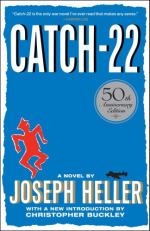|
|
Catch-22 Author/Context
Joseph Heller was born on May 1, 1923 amidst the seashore attractions and famous hot-dog stands of New York's Coney Island. Fatherless, he grew up with his Russian-immigrant mother and two older half-siblings, Lee and Silvia. Though times were tough during the Depression, Heller was insulated by a close-knit Jewish-Italian neighborhood. An occasional prankster, young Joseph's mother often griped that he had a "twisted brain." Heller would use this fanciful imagination in numerous short stories, novels, and plays, with Catch-22 and Something Happened among his most famous compositions.
After working as a telegram delivery boy for Western Union and a blacksmith's helper in a navy yard, Heller enlisted in the United States Air Force in 1942 at the age of nineteen. His experiences as a B-25 wing bombardier during World War II provided the inspiration for Catch-22. Like his charactersYossarian and Clevinger in the novel, he attended aviation training at Santa Ana Army Air Base in California. Later stationed in Corsica, Heller enjoyed one of the most comfortable, best-equipped canvas tents in the squadron. His patient, handy, undersized roommate Ritter would become the novel's good-natured and crash-prone pilot, Orr. Major Cover, an apartment-hunting executive officer in Heller's group, became Major ---- de Coverly, and a close friend named Joe Chrenko provided a thin basis for the character of Hungry Joe.
A soldier named Francis Yohannon lived in a tent nearby and bought a cocker spaniel. Heller modified the unconventional surname for his peculiar hero, Yossarian, and swapped the spaniel for Huple's suffocating cat. The rest of Yossarian's character is a combination of Heller's imagination and Heller himself. Fear of death and the hatred of flying exhibited by the fictional bombardier are directly pulled from Heller's own emotions. The mission to Avignon is largely biographical as well; like Yossarian, Heller tended to the torn leg of a wounded top-gunner amidst bursting flak on that turbulent flight. In 1944, Heller completed his tour of duty, then defined at sixty missions, and waited eagerly to be transported back to the United States.
Heller knew that he could not return to Coney Island after the war. Instead, he married Shirley Held in 1945 and moved to California. The G.I. bill made it possible for Heller to attend the University of Southern California where he pursued his dream of becoming a writer. Heller fathered two children, Erica and Theodore, divorced, and married a second woman named Valerie Humphries. Though dabbling in advertising and teaching, Heller was passionate about writing all of his life. He died in New York in 1999, suffering a heart attack at the age of seventy-six.
The huge and enduring success of Catch-22 established Joseph Heller as a major author in contemporary American literature. An anti-war statement, an indictment of free enterprise, an exploration of sanity, and also a slap-stick parody, Catch-22 continually surprises and captivates with its brilliant interchange of comedy and tragedy. As critic Louis Hasley wrote in his 1974 review, "Dramatic Tension in 'Catch-22,'": "[The] alternating play of humor and horror [in Catch-22] creates a dramatic tension throughout that allows the book to be labeled as a classic both of humor and of war...The laughter repeadedly breaks through the tight net of frustration in which the characters struggle only to sink back as the net repairs itself and holds the reader prisoner in its outrageous bonds." (Bryfonski, 173).
Bibliography
Bryfonski, Phyllis and Carmel Mendelson, eds. Contemporary Literary Criticism, v. 8. Detroit: Gale Research, 1978.
Heller, Joseph. Catch-22. New York: Simon & Schuster Inc., 1996.
Heller, Joseph. Now and Then: From Coney Island to Here. New York: Alfred A. Knopf, Inc., 1998.
Harte, Barbara and Carolyn Riley, eds. Contemporary Authors, New Revision Series, v. 66. Detroit: Gale Research, 1969.
Moritz, Charles, ed. Current Biography: 1973. New York: H.W. Wilson Co., 1974.




